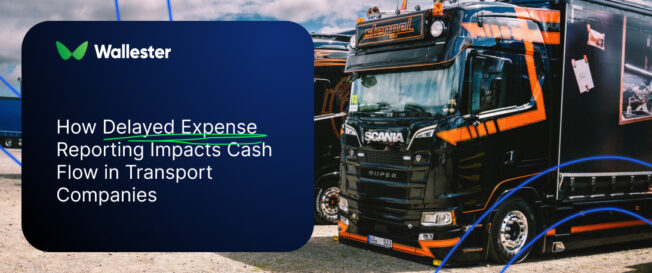Cash flow is what keeps logistics operations running. Businesses spend day in, day out on essentials like fuel, drivers’ wages, insurance, and maintenance – often before they even deliver a shipment. When expense reporting drags, planning starts to unravel and liquidity gets strained. In the UK, more than 50 percent of B2B invoices were overdue in 2025, putting serious pressure on cash flow across the transport and logistics sector.
An overview of the transportation and logistics industry
Transport and logistics sit quietly in the background of daily life, yet nothing works without them. Every supermarket shelf, factory line, and online order depends on trucks, ships, planes, or trains moving goods at the right time. In the UK and across Europe, the sector represents one of the largest parts of the economy, employing millions and generating hundreds of billions of euros each year.
It’s an industry that never really stops. Vehicles clock up thousands of miles a week, warehouses handle goods round the clock, and technology keeps supply chains stitched together. To stay competitive, companies have to invest heavily in vehicles, storage facilities, fuel, and IT systems while dealing with constant pressure from customers to cut costs and speed up deliveries.
Margins are thin, which makes financial discipline critical. Payments from clients can take weeks to arrive, yet drivers, suppliers, and insurers expect money on time. If expense reports come in late, management decisions are based on incomplete information. That lack of visibility makes it harder to keep operations smooth and cash available when it’s needed most.
Further Reading: The Complete Guide to Managing Expenses for Transport & Logistics Companies
Transport and logistics costs
Transport businesses face a wide variety of costs, some predictable and others fluctuating. Among the most significant are:
- Fuel: One of the largest expenses. Even small shifts in oil prices can impact profitability.
- Labour: Drivers, warehouse staff, and support teams form a substantial portion of operating costs.
- Fleet maintenance: Vehicles need regular servicing, parts replacement, and compliance checks.
- Insurance: Covering vehicles, goods in transit, and liability adds recurring annual expenses.
- Tolls and permits: Cross-border operations require permits and regular toll payments.
- Warehousing: Storage, utilities, and security create ongoing financial obligations.
Many of these expenses must be paid before revenue arrives. That’s why cash flow becomes strained. If expense reports arrive late, managers cannot see the full picture of where money is going and where savings could be made.
Why optimising cash flow is important in the transportation and logistics industry
A steady cash flow is essential to keep operations running without disruption. Unlike some sectors, logistics cannot pause payments. Drivers must receive wages on time, fuel suppliers require prompt settlement, and vehicles need maintenance regardless of incoming revenue.
Optimising cash flow gives companies:
- Operational stability – ensuring fleets stay on the road without interruptions.
- Supplier confidence – strong liquidity improves bargaining power when negotiating payment terms.
- Growth capacity – with enough liquidity, companies can bid for new contracts and expand services.
- Resilience – building cash buffers helps absorb shocks like fuel spikes or demand drops.
Poor cash flow forces firms into short-term borrowing, which increases costs further. Optimisation is therefore an operational necessity.
The challenges of cash flow optimisation
Cash flow optimisation in logistics is complex because multiple pressures converge at once. Among the most common challenges are:
- Seasonal fluctuations.Demand rises during peak seasons, such as holidays, then falls during quieter months. Fixed costs, however, remain constant.
- Delayed customer payments.Invoices often take 30-90 days to clear. In the meantime, transport companies must pay fuel, wages, and leasing fees upfront.
- Rising operational costs.Fuel and maintenance prices shift unpredictably. Driver shortages push wages higher, further tightening margins.
- Regulatory obligations.Taxes, permits, and compliance costs are unavoidable. Delays in paying these lead to penalties.
- Inefficient reporting.If expenses are not reported promptly, management decisions rely on outdated information.
Further Reading: Top Expense Policy Mistakes in Transport Companies and How to Fix Them
The impact of delayed expense reporting on cash flow in transport companies
Delayed expense reporting creates blind spots. If drivers submit receipts weeks late or departments fail to log costs promptly, finance teams lose track of actual outflows. This leads to several issues:
- Unreliable forecasts. Budgets cannot be trusted when expenses are missing from the system.
- Payment delays. Reimbursement claims pile up, causing friction with employees.
- Overdrawn accounts. Without up-to-date data, managers risk overdrawing accounts or exceeding credit limits.
- Missed savings opportunities. Late reports prevent early detection of overspending on fuel, repairs, or tolls.
- Strained supplier relations. If reporting delays lead to late payments, suppliers lose confidence.
Over time, this erodes financial stability. Transport firms may appear profitable but still struggle with liquidity because the timing of inflows and outflows is mismatched.

The best strategies for optimising cash flow
Transport firms can take practical steps to stabilise cash flow even under tight margins. Effective strategies include:
- Strengthen invoicing and collections.Issue invoices promptly after service completion and use automated reminders for overdue payments.
- Negotiate supplier terms.Building good relationships with suppliers can help secure longer payment windows.
- Improve expense reporting.Adopt digital tools that allow drivers and employees to submit expenses immediately through mobile apps.
- Maintain rolling forecasts.Weekly or monthly forecasts give visibility into upcoming gaps, enabling proactive adjustments.
- Consider financing options.Invoice factoring and short-term credit lines provide liquidity to bridge gaps without relying solely on reserves.
Together, these measures give firms more predictable cash flow and reduce dependency on expensive emergency loans.
How real-time expense visibility improves decision-making in logistics companies
Real-time expense visibility gives managers a clear picture of current financial commitments. With accurate data available instantly, they can:
- Approve or decline spending requests quickly.
- Spot irregularities before they grow into large problems.
- Allocate budgets effectively across teams and routes.
- Avoid duplicate or fraudulent claims.
- Forecast future liquidity with greater confidence.
In practice, this means companies can respond faster to changing market conditions. For example, if fuel expenses rise sharply, managers can adjust routes or negotiate bulk contracts immediately instead of discovering the issue weeks later through delayed reports.
Further Reading: Top Ways to Streamline Expense Management Across Transport and Logistics
Harness modern expense reporting technologies to optimise cash flow
Modern technology helps close the gap between spending and reporting. Key solutions include:
- Mobile apps for drivers. Allow instant receipt capture, so expenses are logged the same day.
- Corporate and virtual cards. Automatically track spending in real time, eliminating paper-based processes.
- Automated workflows. Route expense approvals to managers quickly, avoiding delays.
- Integration with accounting systems. Ensures transactions are reconciled instantly, keeping records accurate.
When companies use these tools, expenses are logged right away and the numbers add up more accurately. Reports don’t pile up, managers see the figures sooner, and cash flow stays predictable. Staff spend less time filling in forms and more time keeping deliveries on track.
The future of logistics payments
Payment practices in logistics are changing quickly, pushed by customer expectations and new technology. Companies are looking for ways to move money as efficiently as they move goods, and several trends are already shaping the future.
One is the shift towards instant settlements. Instead of waiting days for transfers to clear, carriers and suppliers are increasingly able to receive funds as soon as deliveries are confirmed. This helps small hauliers in particular, since they often struggle with long payment terms.
Another is the wider use of virtual cards. Giving drivers or subcontractors a dedicated card for fuel, tolls, or lodging makes every transaction traceable in real time. Finance teams see where money goes straight away, which reduces disputes and improves control compared with paper receipts or cash advances.
Logistics firms are also starting to apply predictive analytics to their finances. By looking at historic payment cycles and current expenses, software can highlight when cash will be tight and suggest adjustments before problems appear. This gives managers time to line up credit, adjust routes, or renegotiate terms rather than reacting to a crisis.
There’s also growing interest in digital contracts that trigger payments automatically. For example, once a shipment is scanned as delivered, an electronic contract can release the agreed funds without manual invoicing. While still in its early stages, this approach could remove much of the friction that slows down settlements today.
Together, these developments point to a future where money moves through supply chains with the same speed and transparency as the goods themselves. Companies that adopt these methods early will be better placed to keep cash flow steady and support growth without the constant drag of delayed payments.
Conclusion
Cash flow management is one of the most important challenges in transport and logistics. Delayed expense reporting worsens the problem by creating blind spots and disrupting forecasts. Without accurate, timely data, companies risk liquidity shortages, strained supplier relations, and missed growth opportunities. By adopting real-time reporting tools, strengthening invoicing practices, and forecasting regularly, transport firms can maintain stability. Technology is making expense reporting quicker and easier to track, and before long, this will be the normal way of working across the industry.
Improve your cash flow with Wallester’s solutions
Wallester, an official Visa partner and participant in the Visa FinTech Fast Track programme, provides logistics companies with modern tools to improve expense management. With Wallester Business, firms can issue unlimited physical and virtual cards instantly, assign individual spending limits, and track all expenses in real time.

Benefits for logistics companies include:
- A free plan with up to 300 virtual cards.
- Real-time monitoring of driver and supplier payments.
- Integration with accounting software for automatic reconciliation.
- Multi-currency support for international routes.
By digitising expenses and offering real-time visibility, Wallester helps logistics firms avoid liquidity gaps, strengthen supplier trust, and focus resources on growth.


